Detailed Report on Brand Management Strategies for ASDA Supermarket
VerifiedAdded on 2023/02/02
|19
|4229
|33
Report
AI Summary
This report provides a detailed analysis of ASDA's brand management strategies. It begins by defining the significance of branding as a marketing tool, exploring its evolution and impact on business practices, with a focus on how ASDA can leverage these strategies. The report then examines the key constituents of a positive brand strategy, including brand loyalty, awareness, perceived quality, association, and proprietary assets. It applies Keller's Brand Equity Model to assess how brands are managed over time, using ASDA as a case study. Furthermore, the report delves into portfolio management strategies, brand hierarchies, and brand equity management, including Markowitz Portfolio Theory and Maslow's Hierarchy of Needs. The analysis extends to evaluating brand leveraging and extension domestically and internationally, highlighting ASDA's partnerships and collaborative efforts. Finally, it assesses techniques for measuring and managing brand value to develop a strong and enduring brand for ASDA. This report offers a comprehensive understanding of branding within an organizational context.
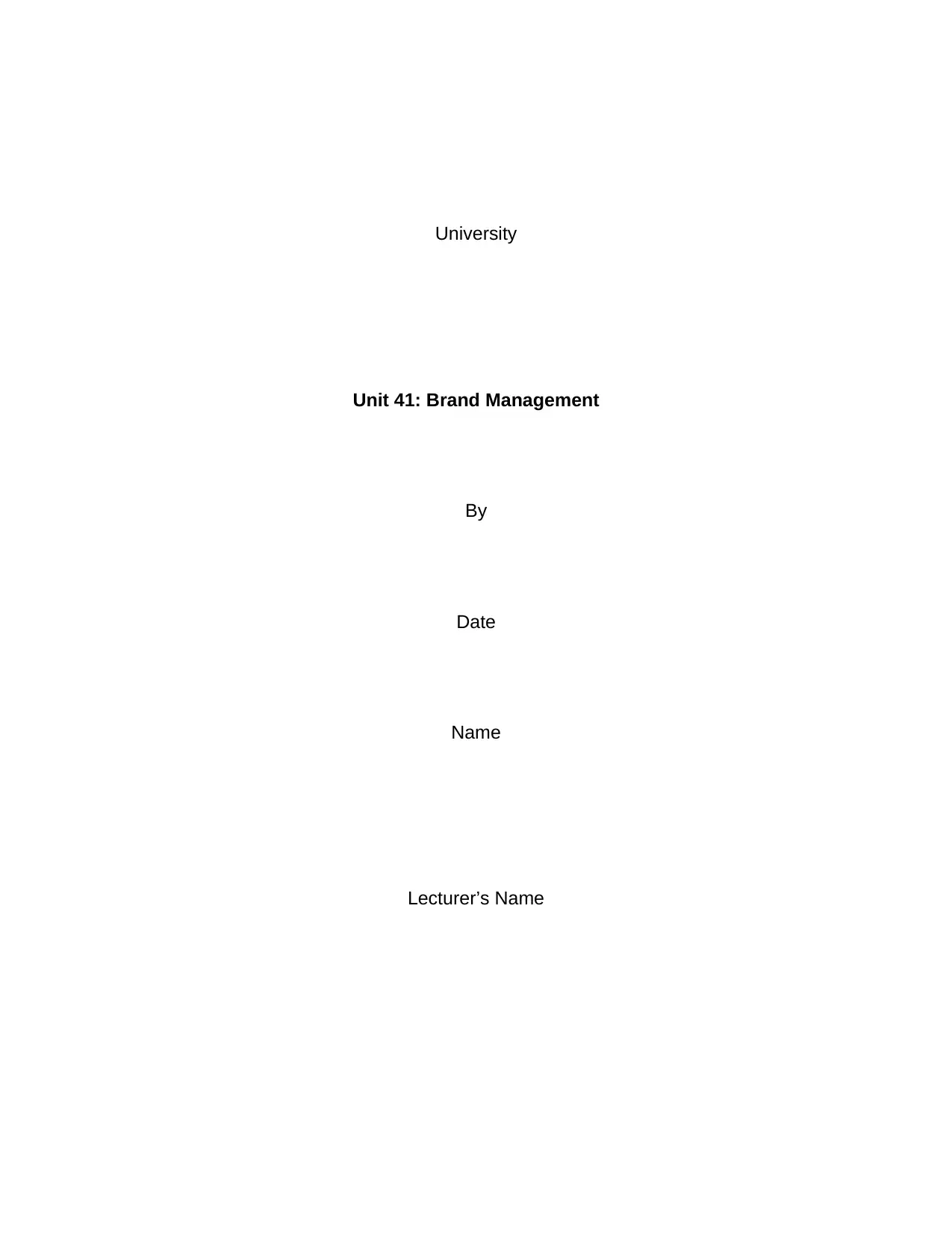
University
Unit 41: Brand Management
By
Date
Name
Lecturer’s Name
Unit 41: Brand Management
By
Date
Name
Lecturer’s Name
Paraphrase This Document
Need a fresh take? Get an instant paraphrase of this document with our AI Paraphraser
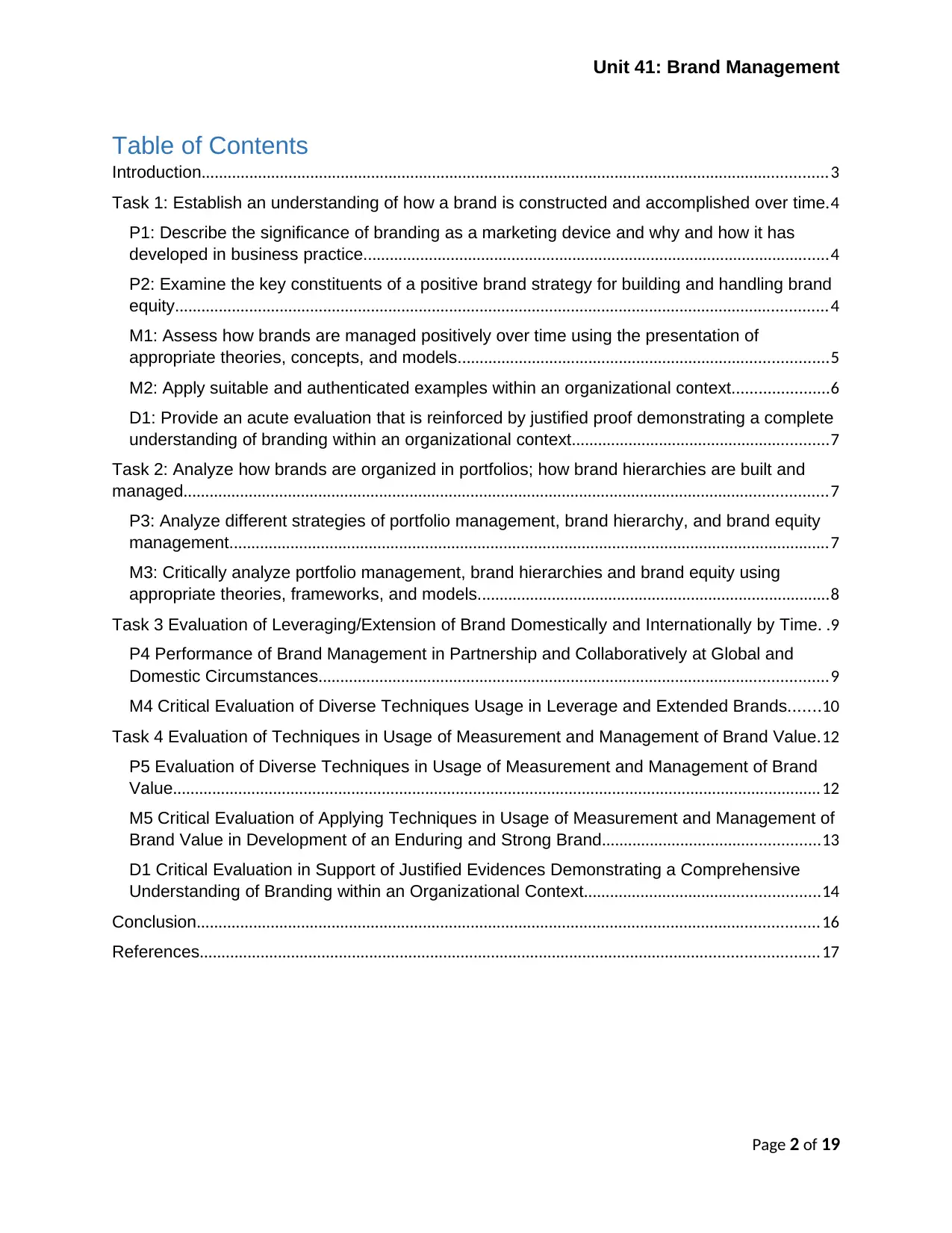
Unit 41: Brand Management
Table of Contents
Introduction................................................................................................................................................3
Task 1: Establish an understanding of how a brand is constructed and accomplished over time.4
P1: Describe the significance of branding as a marketing device and why and how it has
developed in business practice...........................................................................................................4
P2: Examine the key constituents of a positive brand strategy for building and handling brand
equity......................................................................................................................................................4
M1: Assess how brands are managed positively over time using the presentation of
appropriate theories, concepts, and models.....................................................................................5
M2: Apply suitable and authenticated examples within an organizational context......................6
D1: Provide an acute evaluation that is reinforced by justified proof demonstrating a complete
understanding of branding within an organizational context...........................................................7
Task 2: Analyze how brands are organized in portfolios; how brand hierarchies are built and
managed....................................................................................................................................................7
P3: Analyze different strategies of portfolio management, brand hierarchy, and brand equity
management..........................................................................................................................................7
M3: Critically analyze portfolio management, brand hierarchies and brand equity using
appropriate theories, frameworks, and models.................................................................................8
Task 3 Evaluation of Leveraging/Extension of Brand Domestically and Internationally by Time. .9
P4 Performance of Brand Management in Partnership and Collaboratively at Global and
Domestic Circumstances.....................................................................................................................9
M4 Critical Evaluation of Diverse Techniques Usage in Leverage and Extended Brands.......10
Task 4 Evaluation of Techniques in Usage of Measurement and Management of Brand Value.12
P5 Evaluation of Diverse Techniques in Usage of Measurement and Management of Brand
Value.....................................................................................................................................................12
M5 Critical Evaluation of Applying Techniques in Usage of Measurement and Management of
Brand Value in Development of an Enduring and Strong Brand..................................................13
D1 Critical Evaluation in Support of Justified Evidences Demonstrating a Comprehensive
Understanding of Branding within an Organizational Context......................................................14
Conclusion...............................................................................................................................................16
References..............................................................................................................................................17
Page 2 of 19
Table of Contents
Introduction................................................................................................................................................3
Task 1: Establish an understanding of how a brand is constructed and accomplished over time.4
P1: Describe the significance of branding as a marketing device and why and how it has
developed in business practice...........................................................................................................4
P2: Examine the key constituents of a positive brand strategy for building and handling brand
equity......................................................................................................................................................4
M1: Assess how brands are managed positively over time using the presentation of
appropriate theories, concepts, and models.....................................................................................5
M2: Apply suitable and authenticated examples within an organizational context......................6
D1: Provide an acute evaluation that is reinforced by justified proof demonstrating a complete
understanding of branding within an organizational context...........................................................7
Task 2: Analyze how brands are organized in portfolios; how brand hierarchies are built and
managed....................................................................................................................................................7
P3: Analyze different strategies of portfolio management, brand hierarchy, and brand equity
management..........................................................................................................................................7
M3: Critically analyze portfolio management, brand hierarchies and brand equity using
appropriate theories, frameworks, and models.................................................................................8
Task 3 Evaluation of Leveraging/Extension of Brand Domestically and Internationally by Time. .9
P4 Performance of Brand Management in Partnership and Collaboratively at Global and
Domestic Circumstances.....................................................................................................................9
M4 Critical Evaluation of Diverse Techniques Usage in Leverage and Extended Brands.......10
Task 4 Evaluation of Techniques in Usage of Measurement and Management of Brand Value.12
P5 Evaluation of Diverse Techniques in Usage of Measurement and Management of Brand
Value.....................................................................................................................................................12
M5 Critical Evaluation of Applying Techniques in Usage of Measurement and Management of
Brand Value in Development of an Enduring and Strong Brand..................................................13
D1 Critical Evaluation in Support of Justified Evidences Demonstrating a Comprehensive
Understanding of Branding within an Organizational Context......................................................14
Conclusion...............................................................................................................................................16
References..............................................................................................................................................17
Page 2 of 19

Unit 41: Brand Management
Introduction
The report is based on the brand management of a selected organization and it is an
informal business report. The organization selected here is ASDA, which is an UK-
based supermarket organization. Headquarter is located in Leeds, West Yorkshire. The
company was founded in the year 1949 with the associated dairies companies of
Yorkshire. Brand management is significant to uplift the sales value and market share of
an organization. Therefore, a detailed explanation of brand management and its
theories and models are applied in this report over ASDA. The report is divided into four
task and each of the tasks has its own functional values. Brand management is an
ongoing procedure that includes consistency and maintaining around someone’s brand
and delivering on the values the company holds dear for forging a positive relationship
with the customers. ASDA can have a strong customer recognition system with the help
of brand management. Besides that, brand management will help ASDA to bring a
competitive edge in the modern market. As a result, the shared values and customer
loyalty of the company will increase accordingly. Thus, brand management is significant
for ASDA to increase credibility as well as ease of purchase.
Page 3 of 19
Introduction
The report is based on the brand management of a selected organization and it is an
informal business report. The organization selected here is ASDA, which is an UK-
based supermarket organization. Headquarter is located in Leeds, West Yorkshire. The
company was founded in the year 1949 with the associated dairies companies of
Yorkshire. Brand management is significant to uplift the sales value and market share of
an organization. Therefore, a detailed explanation of brand management and its
theories and models are applied in this report over ASDA. The report is divided into four
task and each of the tasks has its own functional values. Brand management is an
ongoing procedure that includes consistency and maintaining around someone’s brand
and delivering on the values the company holds dear for forging a positive relationship
with the customers. ASDA can have a strong customer recognition system with the help
of brand management. Besides that, brand management will help ASDA to bring a
competitive edge in the modern market. As a result, the shared values and customer
loyalty of the company will increase accordingly. Thus, brand management is significant
for ASDA to increase credibility as well as ease of purchase.
Page 3 of 19
⊘ This is a preview!⊘
Do you want full access?
Subscribe today to unlock all pages.

Trusted by 1+ million students worldwide
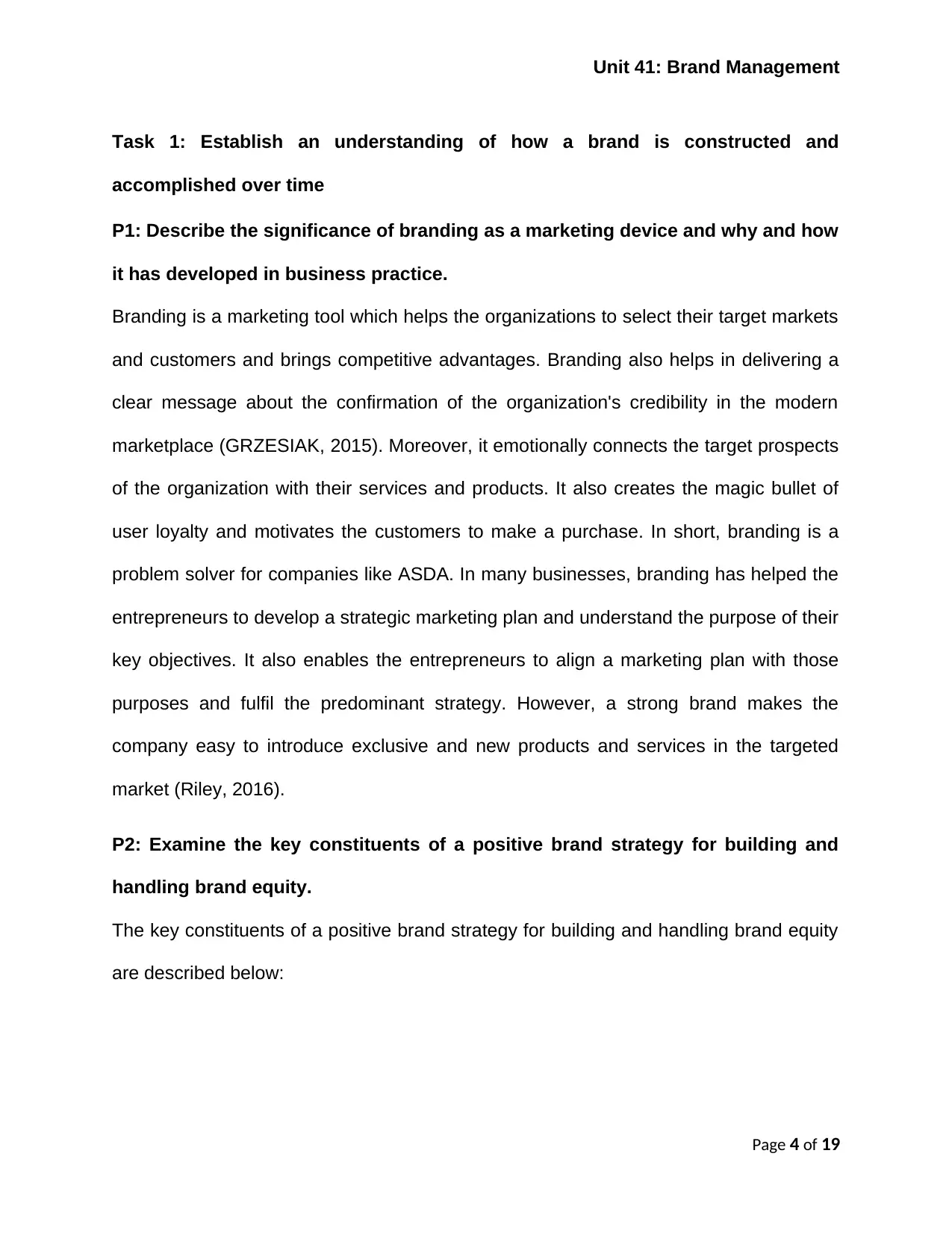
Unit 41: Brand Management
Task 1: Establish an understanding of how a brand is constructed and
accomplished over time
P1: Describe the significance of branding as a marketing device and why and how
it has developed in business practice.
Branding is a marketing tool which helps the organizations to select their target markets
and customers and brings competitive advantages. Branding also helps in delivering a
clear message about the confirmation of the organization's credibility in the modern
marketplace (GRZESIAK, 2015). Moreover, it emotionally connects the target prospects
of the organization with their services and products. It also creates the magic bullet of
user loyalty and motivates the customers to make a purchase. In short, branding is a
problem solver for companies like ASDA. In many businesses, branding has helped the
entrepreneurs to develop a strategic marketing plan and understand the purpose of their
key objectives. It also enables the entrepreneurs to align a marketing plan with those
purposes and fulfil the predominant strategy. However, a strong brand makes the
company easy to introduce exclusive and new products and services in the targeted
market (Riley, 2016).
P2: Examine the key constituents of a positive brand strategy for building and
handling brand equity.
The key constituents of a positive brand strategy for building and handling brand equity
are described below:
Page 4 of 19
Task 1: Establish an understanding of how a brand is constructed and
accomplished over time
P1: Describe the significance of branding as a marketing device and why and how
it has developed in business practice.
Branding is a marketing tool which helps the organizations to select their target markets
and customers and brings competitive advantages. Branding also helps in delivering a
clear message about the confirmation of the organization's credibility in the modern
marketplace (GRZESIAK, 2015). Moreover, it emotionally connects the target prospects
of the organization with their services and products. It also creates the magic bullet of
user loyalty and motivates the customers to make a purchase. In short, branding is a
problem solver for companies like ASDA. In many businesses, branding has helped the
entrepreneurs to develop a strategic marketing plan and understand the purpose of their
key objectives. It also enables the entrepreneurs to align a marketing plan with those
purposes and fulfil the predominant strategy. However, a strong brand makes the
company easy to introduce exclusive and new products and services in the targeted
market (Riley, 2016).
P2: Examine the key constituents of a positive brand strategy for building and
handling brand equity.
The key constituents of a positive brand strategy for building and handling brand equity
are described below:
Page 4 of 19
Paraphrase This Document
Need a fresh take? Get an instant paraphrase of this document with our AI Paraphraser

Unit 41: Brand Management
Brand Loyalty: It defines the level of customer attachment to a particular brand when a
company is facing a competitive heat in terms of repetitive purchase, quality, and price.
Therefore, price reduction in products can bring new customers.
Brand Awareness: The objective of brand awareness is to establish awareness among
the customers about the details of the brand. It creates a signalling commitment which
makes a company's brand worthy from the customer's perspective (Leijerholt, Chapleo
and O’Sullivan, 2018).
Perceived quality of Brand: It contributes to sustainable brand equity and building trust
among the customers. The customers find a reason to buy the brand.
Brand Association: A brand association can be formed on customers contact with the
company and its workers, advertisement, words of mouth publicity and the quality of the
product. A positive brand association can be formed if the product which the brand
portrays is desirable, durable and marketable.
Proprietary Assets: These characteristics add to the competitive advantage of a
company's brand and the protection of the brand from competition over time. It includes
intellectual properties, established relationships, trademarks, and patents (CAKMAK,
2016).
M1: Assess how brands are managed positively over time using the presentation
of appropriate theories, concepts, and models.
Application of Keller's Brand Equity Model
Page 5 of 19
Brand Loyalty: It defines the level of customer attachment to a particular brand when a
company is facing a competitive heat in terms of repetitive purchase, quality, and price.
Therefore, price reduction in products can bring new customers.
Brand Awareness: The objective of brand awareness is to establish awareness among
the customers about the details of the brand. It creates a signalling commitment which
makes a company's brand worthy from the customer's perspective (Leijerholt, Chapleo
and O’Sullivan, 2018).
Perceived quality of Brand: It contributes to sustainable brand equity and building trust
among the customers. The customers find a reason to buy the brand.
Brand Association: A brand association can be formed on customers contact with the
company and its workers, advertisement, words of mouth publicity and the quality of the
product. A positive brand association can be formed if the product which the brand
portrays is desirable, durable and marketable.
Proprietary Assets: These characteristics add to the competitive advantage of a
company's brand and the protection of the brand from competition over time. It includes
intellectual properties, established relationships, trademarks, and patents (CAKMAK,
2016).
M1: Assess how brands are managed positively over time using the presentation
of appropriate theories, concepts, and models.
Application of Keller's Brand Equity Model
Page 5 of 19
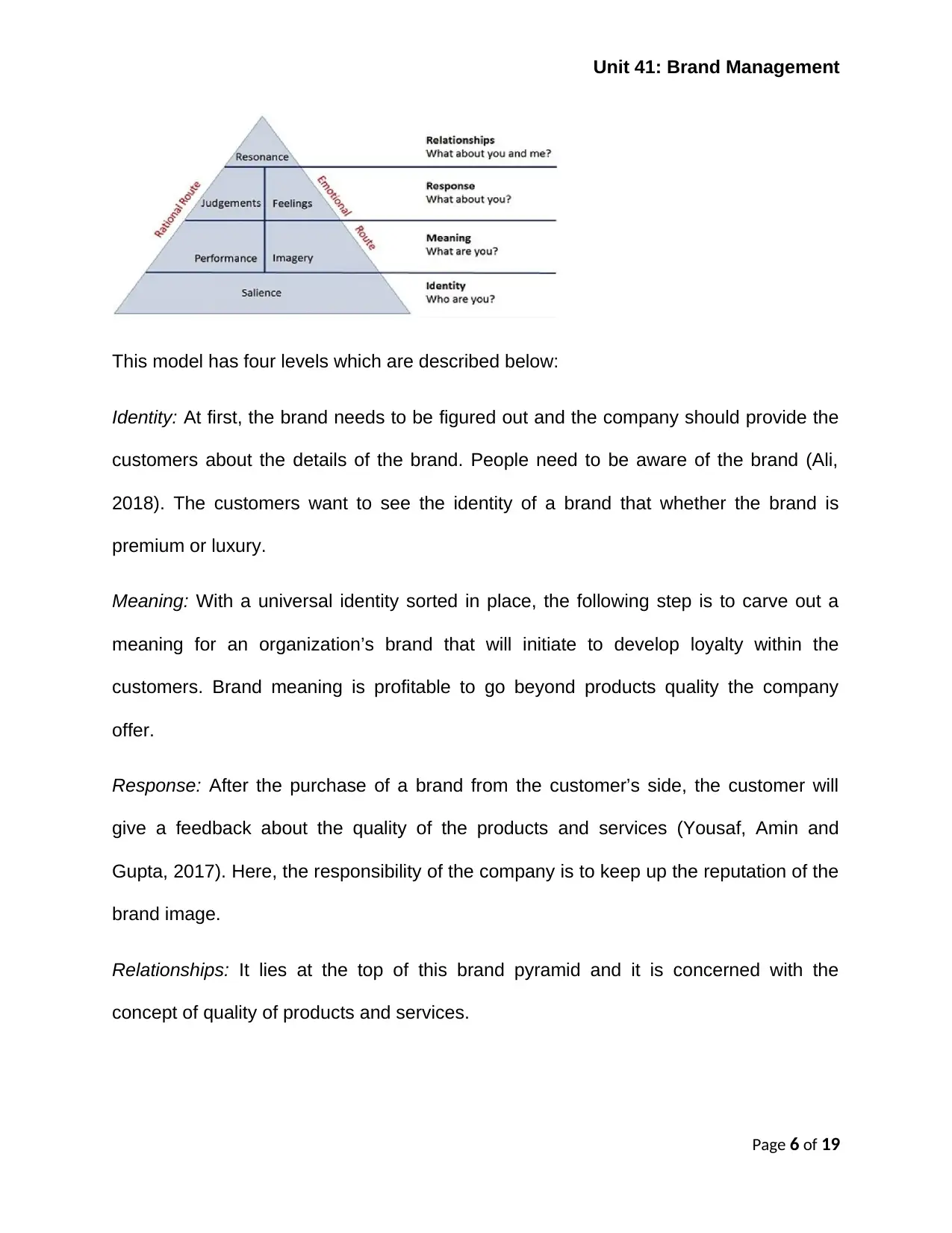
Unit 41: Brand Management
This model has four levels which are described below:
Identity: At first, the brand needs to be figured out and the company should provide the
customers about the details of the brand. People need to be aware of the brand (Ali,
2018). The customers want to see the identity of a brand that whether the brand is
premium or luxury.
Meaning: With a universal identity sorted in place, the following step is to carve out a
meaning for an organization’s brand that will initiate to develop loyalty within the
customers. Brand meaning is profitable to go beyond products quality the company
offer.
Response: After the purchase of a brand from the customer’s side, the customer will
give a feedback about the quality of the products and services (Yousaf, Amin and
Gupta, 2017). Here, the responsibility of the company is to keep up the reputation of the
brand image.
Relationships: It lies at the top of this brand pyramid and it is concerned with the
concept of quality of products and services.
Page 6 of 19
This model has four levels which are described below:
Identity: At first, the brand needs to be figured out and the company should provide the
customers about the details of the brand. People need to be aware of the brand (Ali,
2018). The customers want to see the identity of a brand that whether the brand is
premium or luxury.
Meaning: With a universal identity sorted in place, the following step is to carve out a
meaning for an organization’s brand that will initiate to develop loyalty within the
customers. Brand meaning is profitable to go beyond products quality the company
offer.
Response: After the purchase of a brand from the customer’s side, the customer will
give a feedback about the quality of the products and services (Yousaf, Amin and
Gupta, 2017). Here, the responsibility of the company is to keep up the reputation of the
brand image.
Relationships: It lies at the top of this brand pyramid and it is concerned with the
concept of quality of products and services.
Page 6 of 19
⊘ This is a preview!⊘
Do you want full access?
Subscribe today to unlock all pages.

Trusted by 1+ million students worldwide
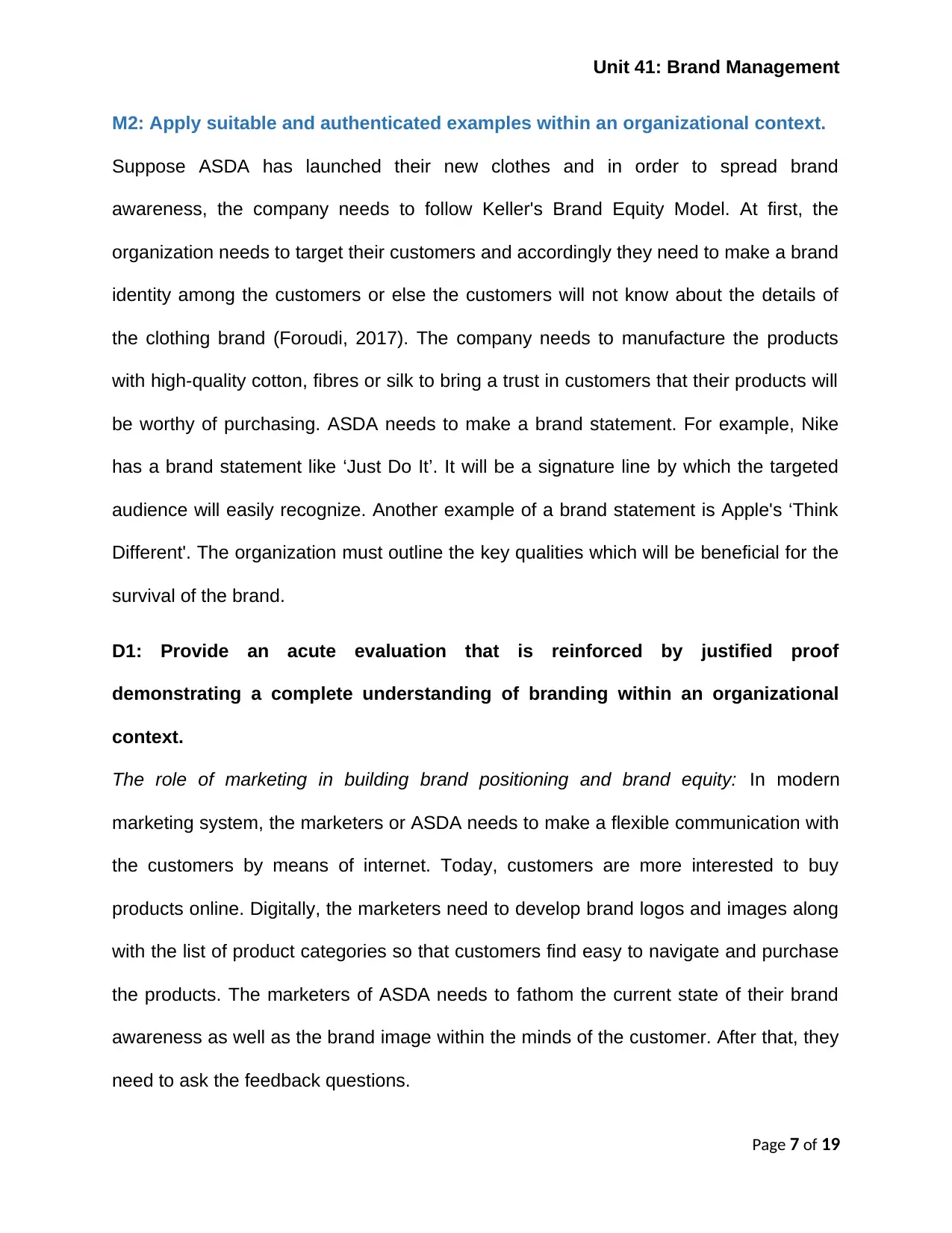
Unit 41: Brand Management
M2: Apply suitable and authenticated examples within an organizational context.
Suppose ASDA has launched their new clothes and in order to spread brand
awareness, the company needs to follow Keller's Brand Equity Model. At first, the
organization needs to target their customers and accordingly they need to make a brand
identity among the customers or else the customers will not know about the details of
the clothing brand (Foroudi, 2017). The company needs to manufacture the products
with high-quality cotton, fibres or silk to bring a trust in customers that their products will
be worthy of purchasing. ASDA needs to make a brand statement. For example, Nike
has a brand statement like ‘Just Do It’. It will be a signature line by which the targeted
audience will easily recognize. Another example of a brand statement is Apple's ‘Think
Different'. The organization must outline the key qualities which will be beneficial for the
survival of the brand.
D1: Provide an acute evaluation that is reinforced by justified proof
demonstrating a complete understanding of branding within an organizational
context.
The role of marketing in building brand positioning and brand equity: In modern
marketing system, the marketers or ASDA needs to make a flexible communication with
the customers by means of internet. Today, customers are more interested to buy
products online. Digitally, the marketers need to develop brand logos and images along
with the list of product categories so that customers find easy to navigate and purchase
the products. The marketers of ASDA needs to fathom the current state of their brand
awareness as well as the brand image within the minds of the customer. After that, they
need to ask the feedback questions.
Page 7 of 19
M2: Apply suitable and authenticated examples within an organizational context.
Suppose ASDA has launched their new clothes and in order to spread brand
awareness, the company needs to follow Keller's Brand Equity Model. At first, the
organization needs to target their customers and accordingly they need to make a brand
identity among the customers or else the customers will not know about the details of
the clothing brand (Foroudi, 2017). The company needs to manufacture the products
with high-quality cotton, fibres or silk to bring a trust in customers that their products will
be worthy of purchasing. ASDA needs to make a brand statement. For example, Nike
has a brand statement like ‘Just Do It’. It will be a signature line by which the targeted
audience will easily recognize. Another example of a brand statement is Apple's ‘Think
Different'. The organization must outline the key qualities which will be beneficial for the
survival of the brand.
D1: Provide an acute evaluation that is reinforced by justified proof
demonstrating a complete understanding of branding within an organizational
context.
The role of marketing in building brand positioning and brand equity: In modern
marketing system, the marketers or ASDA needs to make a flexible communication with
the customers by means of internet. Today, customers are more interested to buy
products online. Digitally, the marketers need to develop brand logos and images along
with the list of product categories so that customers find easy to navigate and purchase
the products. The marketers of ASDA needs to fathom the current state of their brand
awareness as well as the brand image within the minds of the customer. After that, they
need to ask the feedback questions.
Page 7 of 19
Paraphrase This Document
Need a fresh take? Get an instant paraphrase of this document with our AI Paraphraser

Unit 41: Brand Management
Task 2: Analyze how brands are organized in portfolios; how brand hierarchies
are built and managed
P3: Analyze different strategies of portfolio management, brand hierarchy, and
brand equity management.
Portfolio management strategies
(a) Efficient market hypothesis: This hypothesis is based on the fact that the data that
distresses the markets is directly accessible. Moreover, it is processed by all the
investors. The managers related to portfolio management strongly believes that market
averages cannot be crushed reliably (Janiszewska and Insch, 2016).
(b) Indexing: With the help of this theory, managers make use of index funds. These
funds are useful to take the benefits of the efficient market hypothesis.
(c) Brand hierarchy strategies: This branding strategy consists of the corporate brand,
family brand, modifiers, and individual brand. With the help of corporate branding,
ASDA can practice marketing by using their company's name as a product brand name.
(d) Brand equity management strategies: Brand equity management is also useful to
improve online brand communication (Baitinger and Papenbrock, 2017). ASDA must be
genuine with their products and provide relevant content in the website. Moreover, they
must maintain a lively social presence and progress customer profiles.
M3: Critically analyze portfolio management, brand hierarchies and brand equity
using appropriate theories, frameworks, and models.
Markowitz Portfolio Theory
Page 8 of 19
Task 2: Analyze how brands are organized in portfolios; how brand hierarchies
are built and managed
P3: Analyze different strategies of portfolio management, brand hierarchy, and
brand equity management.
Portfolio management strategies
(a) Efficient market hypothesis: This hypothesis is based on the fact that the data that
distresses the markets is directly accessible. Moreover, it is processed by all the
investors. The managers related to portfolio management strongly believes that market
averages cannot be crushed reliably (Janiszewska and Insch, 2016).
(b) Indexing: With the help of this theory, managers make use of index funds. These
funds are useful to take the benefits of the efficient market hypothesis.
(c) Brand hierarchy strategies: This branding strategy consists of the corporate brand,
family brand, modifiers, and individual brand. With the help of corporate branding,
ASDA can practice marketing by using their company's name as a product brand name.
(d) Brand equity management strategies: Brand equity management is also useful to
improve online brand communication (Baitinger and Papenbrock, 2017). ASDA must be
genuine with their products and provide relevant content in the website. Moreover, they
must maintain a lively social presence and progress customer profiles.
M3: Critically analyze portfolio management, brand hierarchies and brand equity
using appropriate theories, frameworks, and models.
Markowitz Portfolio Theory
Page 8 of 19
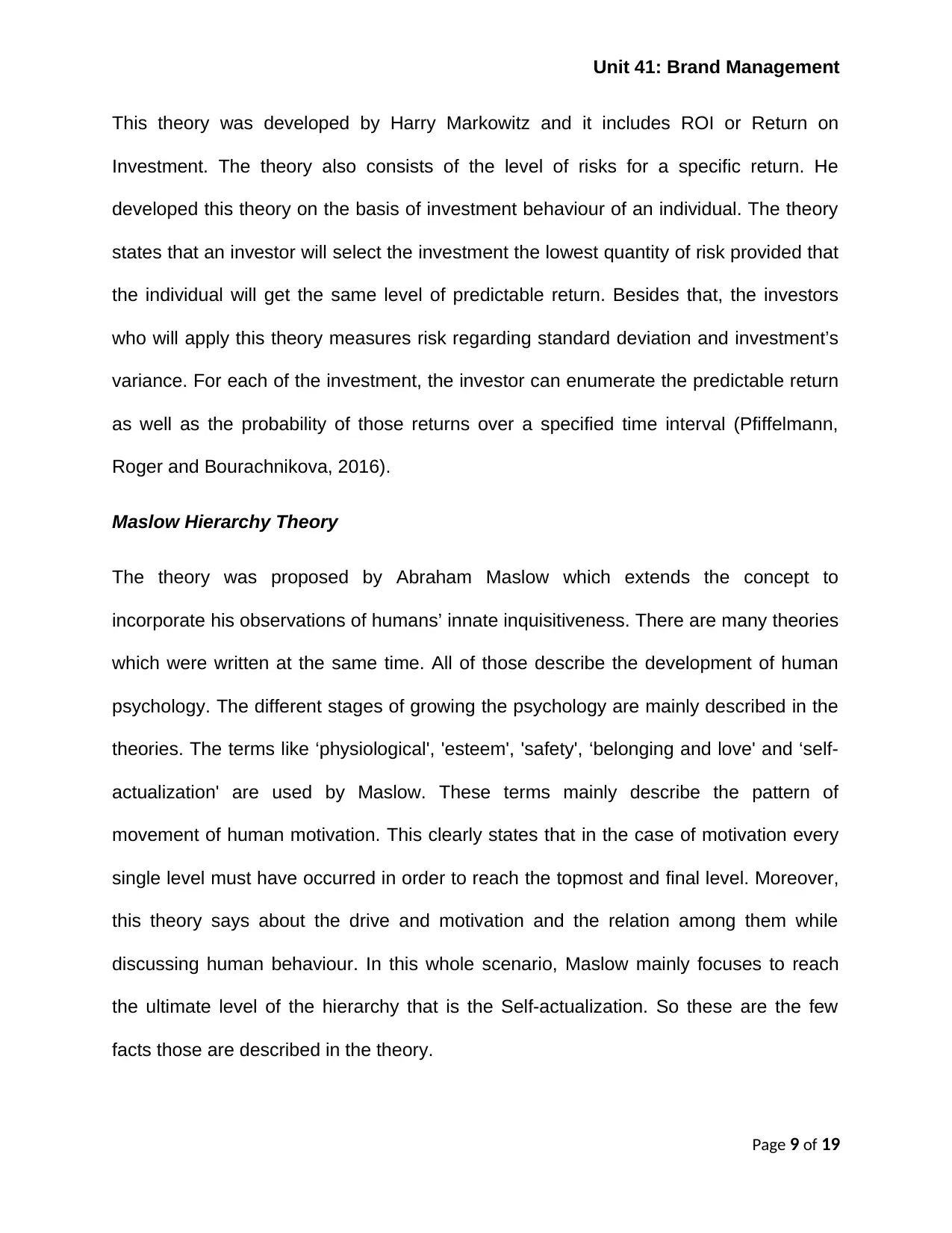
Unit 41: Brand Management
This theory was developed by Harry Markowitz and it includes ROI or Return on
Investment. The theory also consists of the level of risks for a specific return. He
developed this theory on the basis of investment behaviour of an individual. The theory
states that an investor will select the investment the lowest quantity of risk provided that
the individual will get the same level of predictable return. Besides that, the investors
who will apply this theory measures risk regarding standard deviation and investment’s
variance. For each of the investment, the investor can enumerate the predictable return
as well as the probability of those returns over a specified time interval (Pfiffelmann,
Roger and Bourachnikova, 2016).
Maslow Hierarchy Theory
The theory was proposed by Abraham Maslow which extends the concept to
incorporate his observations of humans’ innate inquisitiveness. There are many theories
which were written at the same time. All of those describe the development of human
psychology. The different stages of growing the psychology are mainly described in the
theories. The terms like ‘physiological', 'esteem', 'safety', ‘belonging and love' and ‘self-
actualization' are used by Maslow. These terms mainly describe the pattern of
movement of human motivation. This clearly states that in the case of motivation every
single level must have occurred in order to reach the topmost and final level. Moreover,
this theory says about the drive and motivation and the relation among them while
discussing human behaviour. In this whole scenario, Maslow mainly focuses to reach
the ultimate level of the hierarchy that is the Self-actualization. So these are the few
facts those are described in the theory.
Page 9 of 19
This theory was developed by Harry Markowitz and it includes ROI or Return on
Investment. The theory also consists of the level of risks for a specific return. He
developed this theory on the basis of investment behaviour of an individual. The theory
states that an investor will select the investment the lowest quantity of risk provided that
the individual will get the same level of predictable return. Besides that, the investors
who will apply this theory measures risk regarding standard deviation and investment’s
variance. For each of the investment, the investor can enumerate the predictable return
as well as the probability of those returns over a specified time interval (Pfiffelmann,
Roger and Bourachnikova, 2016).
Maslow Hierarchy Theory
The theory was proposed by Abraham Maslow which extends the concept to
incorporate his observations of humans’ innate inquisitiveness. There are many theories
which were written at the same time. All of those describe the development of human
psychology. The different stages of growing the psychology are mainly described in the
theories. The terms like ‘physiological', 'esteem', 'safety', ‘belonging and love' and ‘self-
actualization' are used by Maslow. These terms mainly describe the pattern of
movement of human motivation. This clearly states that in the case of motivation every
single level must have occurred in order to reach the topmost and final level. Moreover,
this theory says about the drive and motivation and the relation among them while
discussing human behaviour. In this whole scenario, Maslow mainly focuses to reach
the ultimate level of the hierarchy that is the Self-actualization. So these are the few
facts those are described in the theory.
Page 9 of 19
⊘ This is a preview!⊘
Do you want full access?
Subscribe today to unlock all pages.

Trusted by 1+ million students worldwide
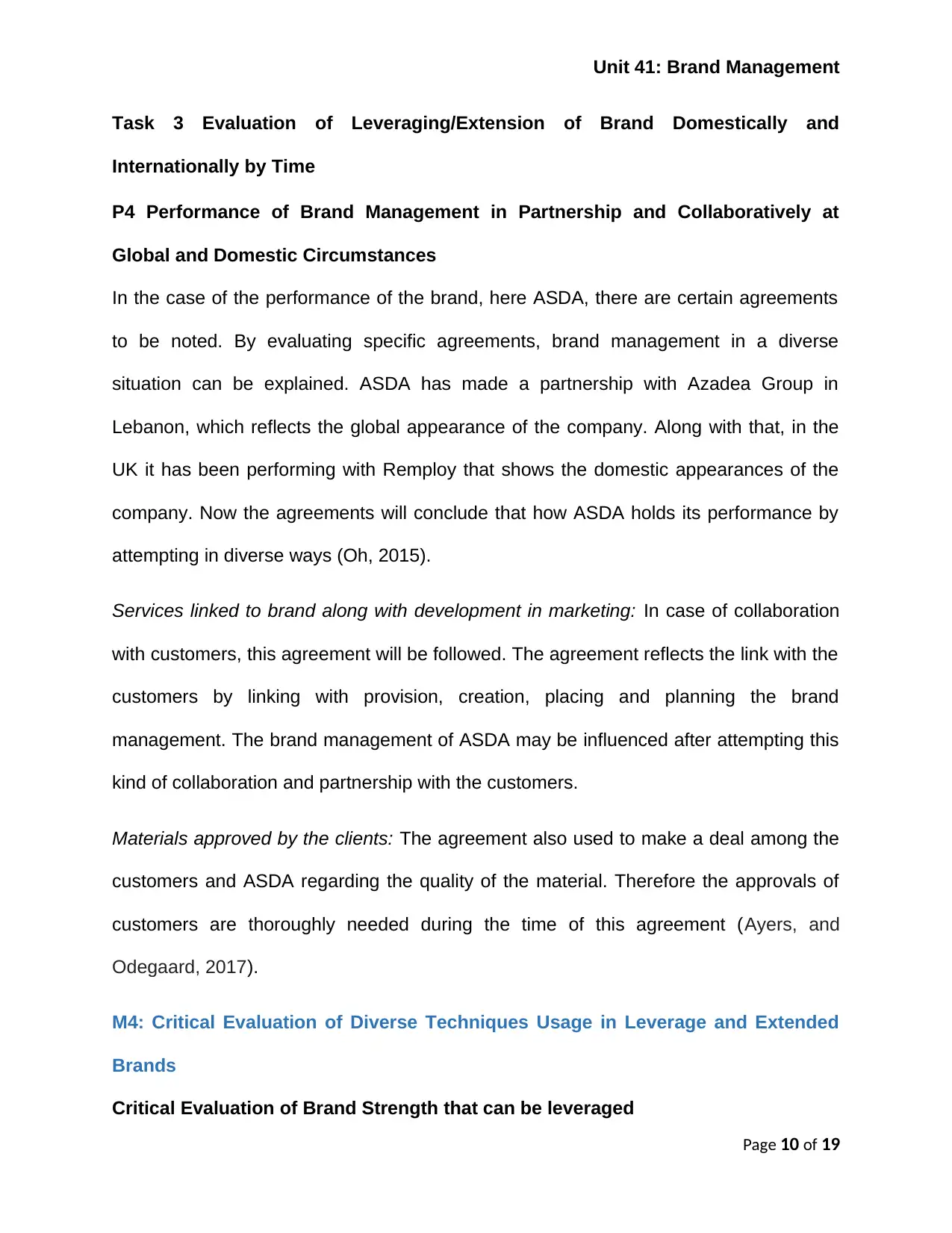
Unit 41: Brand Management
Task 3 Evaluation of Leveraging/Extension of Brand Domestically and
Internationally by Time
P4 Performance of Brand Management in Partnership and Collaboratively at
Global and Domestic Circumstances
In the case of the performance of the brand, here ASDA, there are certain agreements
to be noted. By evaluating specific agreements, brand management in a diverse
situation can be explained. ASDA has made a partnership with Azadea Group in
Lebanon, which reflects the global appearance of the company. Along with that, in the
UK it has been performing with Remploy that shows the domestic appearances of the
company. Now the agreements will conclude that how ASDA holds its performance by
attempting in diverse ways (Oh, 2015).
Services linked to brand along with development in marketing: In case of collaboration
with customers, this agreement will be followed. The agreement reflects the link with the
customers by linking with provision, creation, placing and planning the brand
management. The brand management of ASDA may be influenced after attempting this
kind of collaboration and partnership with the customers.
Materials approved by the clients: The agreement also used to make a deal among the
customers and ASDA regarding the quality of the material. Therefore the approvals of
customers are thoroughly needed during the time of this agreement (Ayers, and
Odegaard, 2017).
M4: Critical Evaluation of Diverse Techniques Usage in Leverage and Extended
Brands
Critical Evaluation of Brand Strength that can be leveraged
Page 10 of 19
Task 3 Evaluation of Leveraging/Extension of Brand Domestically and
Internationally by Time
P4 Performance of Brand Management in Partnership and Collaboratively at
Global and Domestic Circumstances
In the case of the performance of the brand, here ASDA, there are certain agreements
to be noted. By evaluating specific agreements, brand management in a diverse
situation can be explained. ASDA has made a partnership with Azadea Group in
Lebanon, which reflects the global appearance of the company. Along with that, in the
UK it has been performing with Remploy that shows the domestic appearances of the
company. Now the agreements will conclude that how ASDA holds its performance by
attempting in diverse ways (Oh, 2015).
Services linked to brand along with development in marketing: In case of collaboration
with customers, this agreement will be followed. The agreement reflects the link with the
customers by linking with provision, creation, placing and planning the brand
management. The brand management of ASDA may be influenced after attempting this
kind of collaboration and partnership with the customers.
Materials approved by the clients: The agreement also used to make a deal among the
customers and ASDA regarding the quality of the material. Therefore the approvals of
customers are thoroughly needed during the time of this agreement (Ayers, and
Odegaard, 2017).
M4: Critical Evaluation of Diverse Techniques Usage in Leverage and Extended
Brands
Critical Evaluation of Brand Strength that can be leveraged
Page 10 of 19
Paraphrase This Document
Need a fresh take? Get an instant paraphrase of this document with our AI Paraphraser
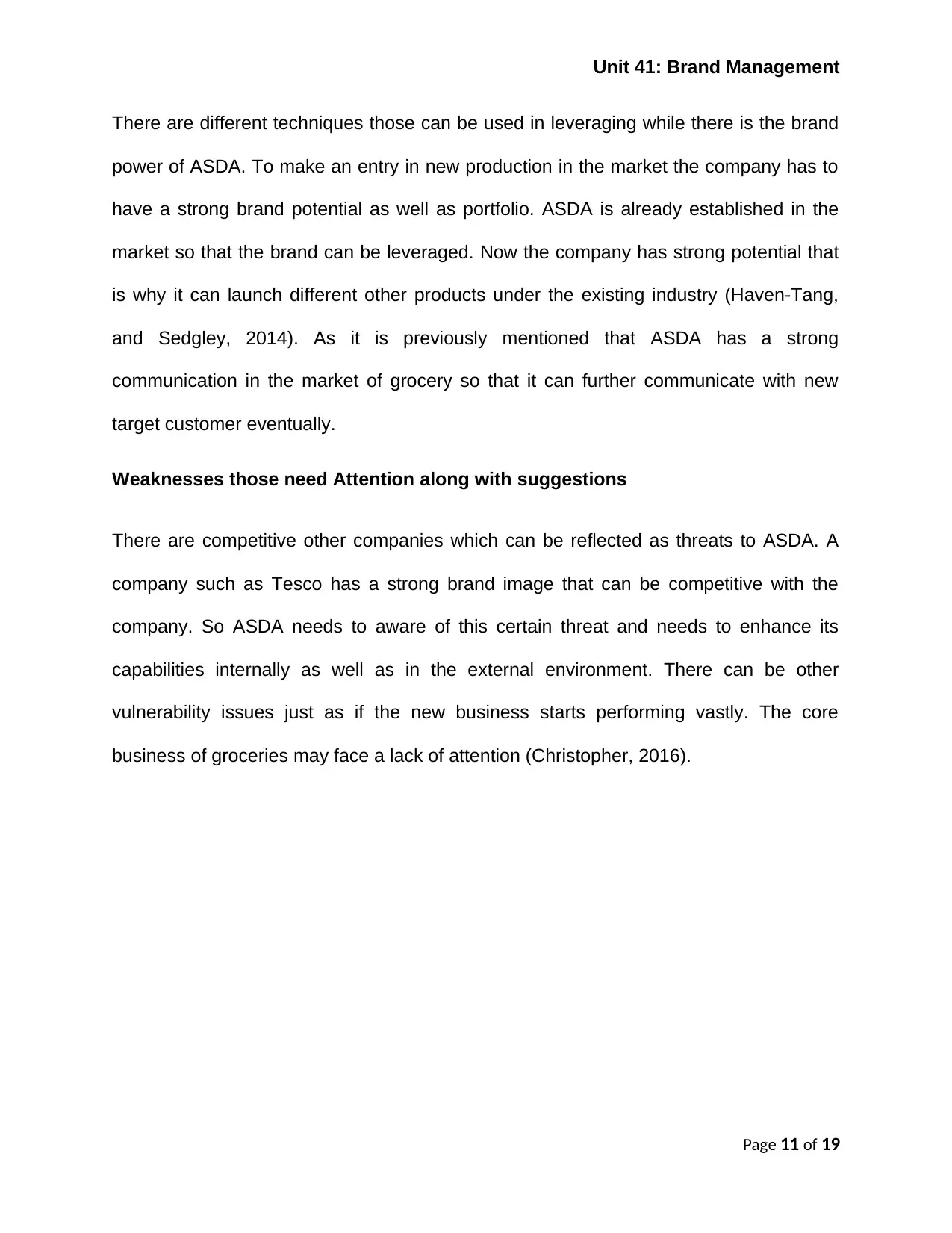
Unit 41: Brand Management
There are different techniques those can be used in leveraging while there is the brand
power of ASDA. To make an entry in new production in the market the company has to
have a strong brand potential as well as portfolio. ASDA is already established in the
market so that the brand can be leveraged. Now the company has strong potential that
is why it can launch different other products under the existing industry (Haven-Tang,
and Sedgley, 2014). As it is previously mentioned that ASDA has a strong
communication in the market of grocery so that it can further communicate with new
target customer eventually.
Weaknesses those need Attention along with suggestions
There are competitive other companies which can be reflected as threats to ASDA. A
company such as Tesco has a strong brand image that can be competitive with the
company. So ASDA needs to aware of this certain threat and needs to enhance its
capabilities internally as well as in the external environment. There can be other
vulnerability issues just as if the new business starts performing vastly. The core
business of groceries may face a lack of attention (Christopher, 2016).
Page 11 of 19
There are different techniques those can be used in leveraging while there is the brand
power of ASDA. To make an entry in new production in the market the company has to
have a strong brand potential as well as portfolio. ASDA is already established in the
market so that the brand can be leveraged. Now the company has strong potential that
is why it can launch different other products under the existing industry (Haven-Tang,
and Sedgley, 2014). As it is previously mentioned that ASDA has a strong
communication in the market of grocery so that it can further communicate with new
target customer eventually.
Weaknesses those need Attention along with suggestions
There are competitive other companies which can be reflected as threats to ASDA. A
company such as Tesco has a strong brand image that can be competitive with the
company. So ASDA needs to aware of this certain threat and needs to enhance its
capabilities internally as well as in the external environment. There can be other
vulnerability issues just as if the new business starts performing vastly. The core
business of groceries may face a lack of attention (Christopher, 2016).
Page 11 of 19
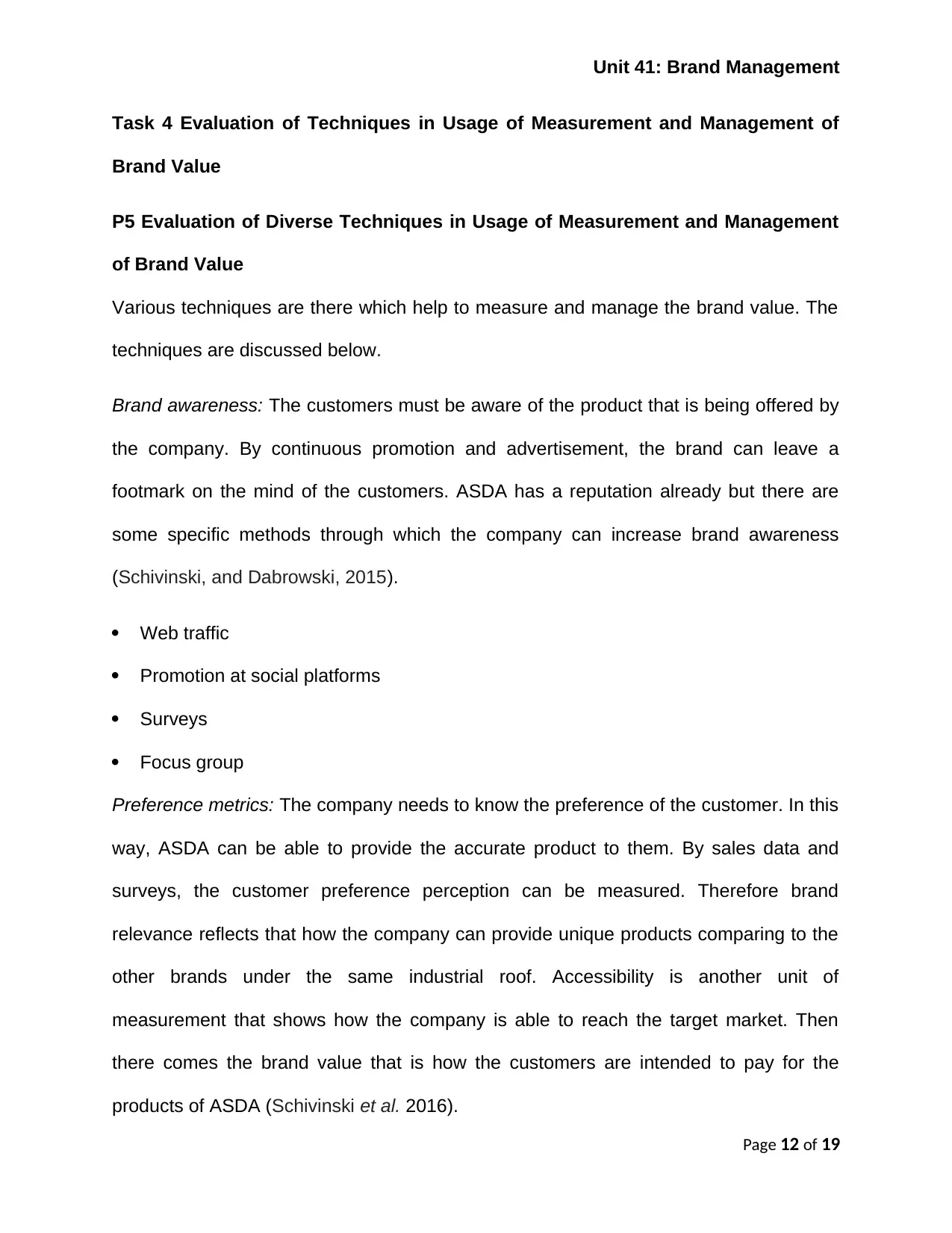
Unit 41: Brand Management
Task 4 Evaluation of Techniques in Usage of Measurement and Management of
Brand Value
P5 Evaluation of Diverse Techniques in Usage of Measurement and Management
of Brand Value
Various techniques are there which help to measure and manage the brand value. The
techniques are discussed below.
Brand awareness: The customers must be aware of the product that is being offered by
the company. By continuous promotion and advertisement, the brand can leave a
footmark on the mind of the customers. ASDA has a reputation already but there are
some specific methods through which the company can increase brand awareness
(Schivinski, and Dabrowski, 2015).
Web traffic
Promotion at social platforms
Surveys
Focus group
Preference metrics: The company needs to know the preference of the customer. In this
way, ASDA can be able to provide the accurate product to them. By sales data and
surveys, the customer preference perception can be measured. Therefore brand
relevance reflects that how the company can provide unique products comparing to the
other brands under the same industrial roof. Accessibility is another unit of
measurement that shows how the company is able to reach the target market. Then
there comes the brand value that is how the customers are intended to pay for the
products of ASDA (Schivinski et al. 2016).
Page 12 of 19
Task 4 Evaluation of Techniques in Usage of Measurement and Management of
Brand Value
P5 Evaluation of Diverse Techniques in Usage of Measurement and Management
of Brand Value
Various techniques are there which help to measure and manage the brand value. The
techniques are discussed below.
Brand awareness: The customers must be aware of the product that is being offered by
the company. By continuous promotion and advertisement, the brand can leave a
footmark on the mind of the customers. ASDA has a reputation already but there are
some specific methods through which the company can increase brand awareness
(Schivinski, and Dabrowski, 2015).
Web traffic
Promotion at social platforms
Surveys
Focus group
Preference metrics: The company needs to know the preference of the customer. In this
way, ASDA can be able to provide the accurate product to them. By sales data and
surveys, the customer preference perception can be measured. Therefore brand
relevance reflects that how the company can provide unique products comparing to the
other brands under the same industrial roof. Accessibility is another unit of
measurement that shows how the company is able to reach the target market. Then
there comes the brand value that is how the customers are intended to pay for the
products of ASDA (Schivinski et al. 2016).
Page 12 of 19
⊘ This is a preview!⊘
Do you want full access?
Subscribe today to unlock all pages.

Trusted by 1+ million students worldwide
1 out of 19
Related Documents
Your All-in-One AI-Powered Toolkit for Academic Success.
+13062052269
info@desklib.com
Available 24*7 on WhatsApp / Email
![[object Object]](/_next/static/media/star-bottom.7253800d.svg)
Unlock your academic potential
Copyright © 2020–2025 A2Z Services. All Rights Reserved. Developed and managed by ZUCOL.


